草稿:大英帝国
 | 本草稿目前為「大英帝国」的草稿。 如有任何疑問,請至討論頁發起討論。 |
大英帝国 British Empire | |
|---|---|
 大英帝国统治范围地图,今英國海外領土的地名以红色下划线表示 |
大英帝国(英語:British Empire)由英国及其之前统治或管理的自治领、殖民地、保护国、国际联盟托管地及其他属地组成。初期多为英国在海外的殖民地,之后是英格兰王国于16世纪末到18世纪初建立的贸易站。从规模上看,大英帝国是历史上最大的帝国,一个多世纪以来都是世界上最重要的大国[1]。到1913年,大英帝国统领超过4.12亿人,占当时世界总人口的23%[2],到1920年国土面积达35,500,000平方公里(13,700,000平方英里)[3],占当时全球陆地面积的24%,对宪政体制、法律、语言和文化产生深远影响。帝国到全盛时期被誉为“日不落帝国”,形容太阳必定会照耀到其中一个领土[4]。
在15到16世纪的地理大发现时期,葡萄牙和西班牙开创了欧洲人探索世界的历程,并在此过程中建立庞大的海外帝国。英国、法国和荷兰羡慕两个帝国享有的巨额财富[5],在美洲和亚洲自行设立殖民地及贸易网络。荷兰在17世纪初期成功取代了西班牙在东南亚地区的霸主地位,控制了欧亚之间的香料贸易[6]。法国在北美洲建立的殖民地面积更是英格兰的数倍。然而英国对殖民地制造业的积极扶持使英属殖民地的人口及繁荣程度远高于他国殖民地,母国对于海外领土的掌控也更加牢固。不列颠还积极使用“大陆均势”外交政策,在法荷战争中与法国结盟重创荷兰,在七年战争中与普鲁士结盟牵制法国,终于在乌德勒支和约与1763巴黎条约后取得了法国在美洲,荷兰在非洲和东南亚的诸多殖民地,并使得世界金融中心由阿姆斯特丹转移至伦敦,让英格兰(1707年联合法令颁布后与苏格兰结为大不列颠王国)登上了世界霸主宝座[7]。
美国独立战争期间的1783年,英国失去北美洲这块殖民时间最长、人口最多的领土,之后英国又与法兰西帝国在拿破仑战争数次交战(1803-1815),尽管最终成功压制了欧洲的革命浪潮,然而英国本身亦在战争中背负沉重债务。18和19世纪之交被视为大英帝国的一次中衰,不过海上霸权依然牢牢掌握在其手中[8]。随着英国工业革命的加速,其生产力大大增加,工业化使得国力极大增长,不列颠又把目光投向亚洲、非洲和太平洋,凭借最强大的海军力量,发展成19世纪最强大的帝国。1815年到1914年的相对和平期期间,英国成为全球霸权,享有“不列颠治世”的美誉。除了名义上控制的殖民地,英国还垄断各地的经济,亚洲、拉丁美洲尤甚[9][10]。由早期白人定居点发展而来的殖民地获得越来越多的自治权利,随着这些由移民主导的领地日趋成熟,英国设置自治领代替了原来的直接统治以降低管理成本。
19世纪中叶的第二次工业革命开始,由于经济对殖民地和金融体系的依赖性不断增强,加之教育系统的缺陷,英国的工业化进程逐渐慢于德美两国。至20世纪初,德国和美国开始挑战英国的经济地位,英德两国的军事角力及经济冲突成为第一次世界大战的一大导火索。这场冲突给英国的军事、财政及人力资源带来庞大压力。尽管一战结束后势力范围达到历史上最大,英国已经不是世界上超群绝伦的工业或军事强国,世界金融中心已由伦敦转移至纽约,英国还欠下了许多外债,面临严重的经济问题。第二次世界大战期间,英国在东亚和东南亚的殖民地被大日本帝国占领,尽管最终不列颠与其盟友取得了全面胜利,然而本就维持艰难的大英帝国终于在战后彻底崩溃。面对美苏联手推动的世界去殖民化运动,英国无力抗争。1947年,为了换取美国援助,英国不得不放松帝国特惠制,这意味着放弃了英国本土对殖民地的货物倾销专营权,极大削弱了英帝国的生存能力。之后为了节省资金,英国不得不开始推动各殖民地独立,大英帝国迅速解体。1956年10月,英法和以色列结成联盟进攻埃及,试图保住苏伊士运河所有权,是为第二次中东战争。尽管军事上联军完全控制塞得港获得了巨大优势,军方甚至表示可以在24小时内攻占运河区,首相艾登还是不得不于美苏两国和第三世界施加的巨大国际压力前妥协,自次月6日单方面宣布停火,这标志着英国彻底失去了世界大国的地位。1997年7月1日香港移交中国被认为是日不落帝国余晖的散尽[11][12]。时至今日,英国仍持有14个海外领土的主权。许多独立后的英国前殖民地加入英联邦这个松散的国际组织,尽管该组织对各成员国无约束力,英国依然可以借此保留一些在世界上的影响。包括英国在内的15个英联邦国家将女皇伊丽莎白二世奉为共同的君主。
1497–1583年:起源
[编辑]
大英帝国成立时,英格兰和苏格兰还是两个独立的王国。1496年,英格兰国王亨利七世眼看西班牙和葡萄牙的海外探险大获成功,委托乔瓦尼·卡博托率领探险队探索经北大西洋前往亚洲的航海路线[13]。克里斯托弗·哥伦比亚首次航行五年后的1497年,卡博托正式出发,最终在纽芬兰岛沿岸登陆。他认为自己已经抵达亚洲,然而并未设立殖民点。次年,卡博托前往美洲,途中舰队遭遇未知变故,没有返航(普遍认为他已经葬身海底)[14]。
英国在16世纪的殖民活动以海盗为主,抢劫对象主要是满载新大陆财宝的西班牙舰队。《1533年上诉限制条例》宣布“英格兰王国是帝国”[15],英国对外殖民的雄心此时已显现出来。不过直到女皇伊丽莎白一世于1550年代在位时,英格兰才打算在美洲设立殖民地[16]。1542年亨利八世与罗马教廷决裂,英国新教改革开始,然而他设立的英国圣公会仅名义上是新教,实际上为“新教中的旧教”。伊丽莎白继续进行父亲的宗教改革,而这导致了英国与信仰天主教的西班牙关系愈加恶化[13]。1562年,伊丽莎白一世怂恿私掠人约翰·霍金斯和法兰西斯·德瑞克到西非沿岸,袭击西班牙和葡萄牙贩运奴隶的船只[17],打算建立大西洋奴隶贸易,被两人断然拒绝。后来英西战争白热化,伊丽莎白一世继续批准私掠突袭西班牙在美洲的港口,以及满载新大陆珍宝,经大西洋返航的西班牙船队。当时,理查德·哈克卢伊特和约翰·迪伊等具影响力的作家开始推动英格兰设立自己的帝国,其中迪伊是首个使用“大英帝国”一词的人[18]。此时西班牙成为美洲的主要统治力量,并开始探索太平洋,葡萄牙则在非洲和巴西设立通往中国和东南亚的堡垒,以阻止别国打破葡萄牙对香料和瓷器贸易的垄断。法国因为皮草贸易在16世纪末开始殖民圣劳伦斯河地区,后来此地区先为新法兰西公司控制,在太阳王时期被直接并入法国,是为新法兰西[19]。
英格兰尽管在建立海外殖民地方面远远落后葡萄牙、西班牙和法国,但于16世纪参考1169年诺曼征服爱尔兰,派英格兰的新教徒到爱尔兰定居,设立首个海外殖民地[20][21]。部分协助建立爱尔兰殖民地的人士后来在殖民北美洲早期扮演重要角色,最为有名的是西部人[22]。
1583–1707年:海外殖民地
[编辑]1578年,伊丽莎白一世向汉弗莱·吉尔伯特颁发发现与海外探勘专利[23][24]。同年,吉尔伯特出发前往加勒比地区,计划进行海盗活动,在北美设立殖民地,但探险队没穿过大西洋便返回[25][26]。1583年,吉尔伯特再度尝试,结果正式宣称纽芬兰岛港口的所有权,不过没有留下定居者。回国途中,吉尔伯特不幸殒命,同母异父的沃尔特·雷利继承衣钵,1584年获伊丽莎白授权,同年在今北卡罗来纳州沿岸建立罗阿诺克殖民地,但因缺乏补给再次失败[27]。
1603年,苏格兰国王詹姆士六世以詹姆士一世之名继承英国王位,1604年与西班牙签订《伦敦条约》,结束敌对状态。与主要的对手和平共处下,英格兰将注意力从掠夺其他国家的殖民设施,转向设立自己的海外殖民地[28]。随着美洲及加勒比海小岛殖民地纷纷设立,负责管理殖民地及海外贸易的东印度公司等股份有限公司不断涌现,大英帝国于17世纪初具规模。部分历史学家将这段时间到美国独立战争结束后十三殖民地丧失的18世纪末称为“第一大英帝国”[29]。
美洲、非洲与奴隶贸易
[编辑]
加勒比海地区最初是英格兰最重要、最有利可图的殖民地[30],但殖民当地的活动历经多次尝试才获得成功。1604年,英格兰带着寻找金矿的目标,在圭亚那设立殖民地,结果没有找到金矿,只维持了两年[31]。之后圣卢西亚(1605年)和格林纳达(1609年)的殖民计划迅速告吹,后来圣基茨岛(1624年)、巴巴多斯(1627年)和尼维斯岛(1628年)的殖民地成功设立[32]。各殖民地不久后采用葡萄牙殖民巴西时利用成功的糖种植业体系。这项体系依靠奴隶工人运作,一开始被荷兰船队用来贩售奴隶、购买糖[33]。为确保日益增长的可观收入留在英格兰手中,议会于1651年通过《航海法案》,只允许英格兰船队在英格兰殖民地贸易,激怒了荷兰共和国,引爆第一次英荷战争,最终英国获得胜利,成功加强了自身在加勒比海的贸易地位[34]。1655年,英格兰从西班牙手中吞并牙买加,1666年成功殖民巴哈马[35]。
1607年,在约翰·史密斯的带领下,英格兰在詹姆斯敦成立首个美洲永久定居点,由弗吉尼亚公司管理。由于1609年弗吉尼亚公司旗舰的海难,百慕大被英格兰占领并宣称拥有主权,并于1615年移交给新成立的萨默斯群岛公司[36]。弗吉尼亚公司的特许状于1624年被撤销,弗吉尼亚的直接控制权由王室接管,从而建立了弗吉尼亚殖民地[37]。伦敦和布里斯托尔公司成立于 1610 年,目的是在纽芬兰建立永久定居点,但基本上没有成功[38]。1620年, 普利茅斯殖民地作为清教徒宗教分离主义者(后来被称为朝圣先辈)的避风港而建立[39]。逃离宗教迫害成为许多英格兰准殖民者冒着艰巨风险跨大西洋航行的动机:马里兰省建立时是罗马天主教徒的避风港(1634), 罗德岛殖民地及普罗维登斯庄园(1636)是宽容所有宗教的殖民地,而康涅狄格州(1639)是公理会的天堂。卡罗莱纳省成立于1663年。随着1664年阿姆斯特丹堡的投降,英格兰获得了对荷兰殖民地新尼德兰的控制权,并将其更名为纽约。这是在第二次英荷战争后的谈判中正式确定的,以换取苏利南[40]。1681年,宾夕法尼亚省殖民地由威廉·佩恩建立。虽然美洲殖民地在经济上不如加勒比地区成功,但这些地区拥有大片优质农田,吸引了更多喜欢温带气候的英格兰移民[41]。
1670年,查理二世通过皇家特许状成立了哈德逊湾公司 (HBC),授予其垄断鲁珀特地毛皮贸易的权利,该地区后来成为加拿大自治领的很大一部分。哈德逊湾公司建立的堡垒和贸易站经常成为法国人攻击的目标,法国人在邻近的新法兰西建立了自己的毛皮贸易殖民地[42]。
两年后,皇家非洲公司成立,从查理国王那里获得了向英属加勒比殖民地供应奴隶的贸易垄断权[43]。从一开始,奴隶制度就是帝国在西印度群岛的基础。直到1807年奴隶贸易的废除,英国运送了三分之一的横渡大西洋的奴隶——350万非洲人[44]。为了促进这种贸易,英国在西非海岸建立了堡垒,例如詹姆斯岛,阿克拉和邦斯岛。在英属加勒比,非裔人口的百分比从1650年的25%上升到了1780年的80%,而在十三殖民地,这一数字在同一时期从10%上升到了40%(主要在南方殖民地)[45]。对奴隶贸易者来说,这种贸易极其有利可图,并且成为布里斯托尔、格拉斯哥和利物浦等西部英国城市的主要经济支柱,构成了与非洲和美洲三角贸易的第三角。在运输期间,恶劣和不卫生的条件以及糟糕的饮食,意味着中段的平均死亡率为七分之一[46]。
对抗欧洲其他帝国
[编辑]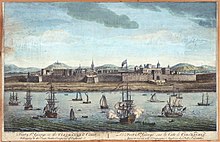
16世纪末,英格兰和荷兰开始挑战葡萄牙对亚洲贸易的垄断地位,成立了私人股份有限公司来资助航海,即英国东印度公司和荷兰东印度公司,二者分别于1600年和1602年获得贸易专利特许。公司的首要目标是开展香料贸易,利润可观;贸易主要集中在两个地区:东印度群岛和印度,印度是重要的贸易中心,他们在此与葡萄牙以及彼此之间竞争贸易主导权[47] 。荷兰在17世纪初期数次于海上击败西班牙帝国,在三十年战争结束后基本上控制了欧亚之间的香料贸易,成为了东南亚的主导力量。尽管英国海外殖民地面积更大,然而荷兰靠垄断的香料贸易赚进了大笔财富,且拥有更加完善的金融系统。1688年光荣革命后,来自荷兰的奥兰治亲王威廉与其妻玛丽共治英格兰,两国结束了敌对关系。而后英荷签订协议,将东印度群岛的香料贸易留给荷兰,将印度的纺织业留给英国。尽管英国在东南亚殖民开始的较晚,然而其稳扎稳打,很快在印度西、东岸及孟加拉地区都建立了据点。依靠着印度丰富的物产以及英国资本主义的快速发展,在18世纪纺织品的利润逐渐超过了香料[48]。
1688年英荷两国恢复和平的另一个原因是针对路易十四治下法兰西王国的大同盟战争开始了, 不过英国在这场战争中显然获利更大,因为荷兰需要参与和法国的陆战,这将迫使其调拨大笔国防预算给陆军,让英国在海上打击荷兰时压力小上不少[49]。 1700年, 西班牙国王卡洛斯二世病逝,法王路易十四的孙子菲利普五世即位成为西班牙国王,法西两国试图合并本土与海外殖民地,成为一个统一的帝国,而这对于英格兰与其他欧洲国家来说是不可接受的[50] 。1701年,英格兰、葡萄牙、荷兰与神圣罗马帝国向西班牙和法国宣战,持续十三年的西班牙王位继承战争爆发[50]。
苏格兰的海外扩张计划
[编辑]1695年,苏格兰议会给予苏格兰公司授权,允许其建立定居点进行海外殖民。1698年苏格兰公司在巴拿马地峡建立殖民地,然而这触犯了西班牙帝国的殖民利益,仅维持了两年就由于邻近西班牙新格林纳达总督辖区的围攻和瘟疫的大流行失败了。达连计划对整个苏格兰来说是一个经济灾难,为了支持这次殖民尝试,整个苏格兰社会四分之一的财富都赔了进去[51]——然而最后什么都没得到,这彻底击碎了苏格兰建立起自己海外帝国的理想。这次计划唯一的作用就是成功说服了苏格兰人与英格兰合并,在17世纪两国就已经形成了共主邦联,不过并未在政治和经济上完成统一。在该计划失败的第二年,大不列颠王国成立[52]。
1707–1783年:“第一”大英帝国
[编辑]
18世纪见证了新诞生的大不列颠王国逐渐成为主导海洋的第一殖民帝国,也因法兰西与英吉利对世界强权的二元争霸而震颤[53] 。直到1714年,这场卷入不列颠、荷兰、葡萄牙、神圣罗马帝国和法国多国参战的漫长西班牙继承战争,才终于以乌德勒支合约的签订而告终。菲利普五世可以继位成为西班牙国王,然而他与他的所有继承人都要放弃对法国王位的宣称,这一战还大大削弱了西班牙的国力,使其彻底丢掉了欧洲强国的地位[50]。不列颠帝国在这场战争结束后领土有所扩张:从法国,英国获得了新法兰西的纽芬兰与新斯科舍等地,从西班牙则获得了战略要冲直布罗陀和梅诺卡岛。直布罗陀成为了英国最重要的海军基地之一,其在之后的200多年中帮助不列颠扼守着从大西洋至地中海最重要的水道。西班牙还将利润丰厚的西属美洲黑奴贸易专营权(asiento)转让给了英国[54]。1739年英西之间詹姆斯的耳朵战争爆发后, 西班牙私掠船在三角贸易航路中打劫英国商船。1746年英西两国开始和谈,西班牙国王同意停止对英国商船的私掠活动,然而在马德里条约中英国也丧失了撒哈拉以南非洲的奴隶贸易经营权[55]。
在东印度,荷兰与英国的商人继续在香料与纺织品贸易上竞争。随着纺织品贸易的规模逐渐超越香料贸易,在1720年之后,英国殖民公司的货物销量压倒了荷兰方面[48]。18世纪中叶有数次军事冲突在印度次大陆上爆发, 这是因为随着莫卧儿帝国的衰落,其原疆域的许多地方出现了权力真空,英法东印度公司在扩张的过程中与当地土著不断发生冲突。1757年普拉西战役爆发,英军击败孟加拉总督与他的法国盟友,自此东印度公司控制了整个孟加拉地区并且成为了印度举足轻重的政治和军事力量[56],而法国不仅丧失了对法属印度的控制,还不得不接受对其在印度军事力量的限制,并被迫负上了对英国从属国提供支持的义务,法国人彻底丧失了控制整个印度的希望[57]。在之后的一个世纪中,英国东印度公司不断增加其控制的土地面积,这其中既有公司直辖的省份,也有慑于省辖军(主要由印度兵组成,配有英国军官的土著军队)而从属于公司的酋长代管的[58]。英国与法国在印度的战役也是卷入大部分欧洲强权、全球性七年战争 (1756–1763) 的一个部分[42]。
1763年巴黎条约的签订对于未来的大英帝国有很大影响。在北美,法国承认了英国对鲁珀特地的声索,并将新法兰西和路易斯安娜一并割让给了不列颠与西班牙(还将一大批法语人口让与了英国),从此法国再无可能崛起成为海洋帝国[42],随后西班牙将佛罗里达也割与英国。七年战争与英国在印度的胜利一起将其送上了世界第一殖民帝国的宝座,并且在之后的一百多年中没有国家将有能力撼动她的地位[59]。
丧失十三殖民地
[编辑]
1760年代至70年代,北美的十三块殖民地与英国本土之间的关系变得愈加紧张,这主要是因为英国议会不断在不经白人殖民者们同意的情况下肆意给他们加税。当时殖民者间的一句口号“无代表,不纳税”谴责了英国政府对英国人权的违反。美国革命开始于一些殖民者对议会权威的挑战与殖民地自治的尝试。不过这很快遭来了当局的报复,英国本土向北美派出部队取缔自治组织并施加直接统治,矛盾激化之下,战争终于在1775年爆发了。次年,也就是1776年7月4日,第二次大陆会议通过美国独立宣言,十三殖民地正式独立。随后法国与西班牙介入战争,大力支援美国,胜利的天平逐渐倒向大陆军。1781年约克镇的惨败后,英国不得不进行和平谈判,最后在1783年的巴黎和约中承认了美国的独立[60]。
英属美洲大片领土的丢失,使得大英帝国自此失去了殖民时间最久、人口最多的一块海外领地,这被一些历史学家定义为界定“第一”与“第二”大英帝国的标志性事件[61],因为英国在此之后将自己的殖民重心由美洲转向了亚洲和太平洋,之后又转往非洲。出版于1776年苏格兰经济学家与哲学家亚当·斯密的著作国富论认为殖民地对帝国来说是多余的,发祥于西班牙和葡萄牙帝国贸易保护主义的重商主义应该被自由贸易取缔,而前者是第一大英帝国的重要特征[59][62]。1783年后独立的美国与英国之间的贸易似乎证明了亚当斯密之观点,即政府管控并非经济发展的必要条件[63][64]。
美国独立战争也间接影响了加拿大的政治环境,大约有40,000至100,000名保皇党人[65]在独立战争期间从美国逃往加拿大[66]。其中的14000人前往了新斯科舍省的圣约翰和圣科罗伊河河谷,由于感到离省政府所在地过远,因此伦敦当局在1784年单独将新斯科舍的一部分划为了新不伦瑞克省[67]。为了消除英语和法语社区之间的紧张局势,1791宪法法案划出了以英语为主的上加拿大和以法语为主的下加拿大,它还创制了一套类似英国本土的行政体系,其目的是加强英伦皇室在加拿大的威望,以免让可能促动独立的共和派在政府中占了上风[68]。
美英关系在拿破仑战争时期再度紧张起来,英国为了反击法兰西帝国的大陆封锁试图阻止中立的美国商船靠岸法国或其盟友的港口,皇家海军还肆意扣留美国船只、征用美国水手。1812年美英战争爆发,美军入侵加拿大,英军随后发动反击,直接进攻美国本土。不过此次战争本质是英国策应欧洲战事,双方又皆未占到便宜,所以在1814年拿破仑战败后美英签订的根特条约中依然保持原有边界。这次战争的最大意义是加拿大和美国自此被分割为了两个国家[69][70]。
1783–1815年:“第二”大英帝国崛起
[编辑]探索太平洋
[编辑]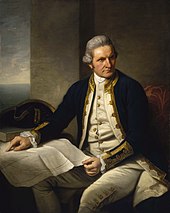
自1718年起,大英帝国就开始以花样繁多的罪名向美洲流放罪犯,每年都有大约1000人[71]。1783年失去北美十三州后英国政府改选澳大利亚为流放地[72]。澳大利亚海岸在1606年首先被荷兰探险家发现[73],但一直没有国家尝试开展殖民活动。1770年英国人詹姆斯·库克在一次科研航行中绘制了澳洲东海岸的地图,宣布此地为大不列颠领土,命名为新南威尔士[74]。1778年,约瑟夫·班克斯作为库克远航中随行的植物学家,向政府提供证据,建言植物学湾适宜建立新的流放地。第一艘载着流放犯人的船只在1787年出发,经过数月航行成功于次年抵达[75]。与往常不同,殖民者仅仅通过一张公告就取得了澳大利亚土地的主权,澳洲原住民被认为过于野蛮,不值得与其订立条约[76][77],而殖民活动伴随的疾病与暴力,给被驱离故土的原住民带来了深重苦难[78][79]。英国此后继续向新南威尔士流放犯人直到1840年,对塔斯马尼亚与西澳大利亚的流放活动分别至1853和1868年才结束[80]。澳大利亚的殖民者很快因为从事出口当地盛产的羊毛与黄金而发家致富[81],由此引发的淘金潮使得维多利亚州首府墨尔本一度成为世界上最富有的城市[82]。
库克在远航中也造访了与澳洲一海之隔的新西兰,这块岛屿在1642年被荷兰探险家阿贝尔·塔斯曼首次发现,1769和1770年,南岛与北岛分别被宣布为大不列颠的领土。开始时,原住民毛利人与欧洲人之间的接触仅限于贸易往来,19世纪初期欧洲人定居点的数量开始增加,数个贸易站被建立起来,其中尤以北岛为多。1839年,新西兰公司宣布计划采购大量土地以在岛上建成殖民地,次年2月6日,威廉·霍布森船长与40个毛利土著酋长签订怀唐伊条约,正式宣布将新西兰纳入英国女王主权的管制之下[83]。该条约如今被认为是新西兰的建国文件[84],然而由于许多英文词汇在毛利语中都无法找到准确的对应意思,该条约的毛利语版本和英文版在不少语义上有歧义[85],因此其至今仍存在争议[86]。
拿破仑战争
[编辑]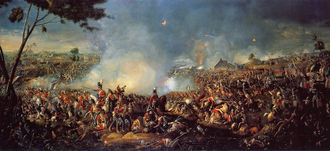
拿破仑治下的法国成为了大英帝国存续的又一个挑战。在战争之外,拿破仑战争更是英法两国在意识形态上的竞争。[87]不仅仅是大英帝国在世界舞台上的领导地位岌岌可危,拿破仑那支横行欧陆的大军更令英国本土枕戈待旦。[88]
因此英国在拿破仑战争中不惜战争成本为取一胜。英国皇家海军封锁了法国港口,并在1805年的特拉法尔加海战中大败法西联合舰队。同时,英国也对法属殖民地发起进攻。荷属殖民地在荷兰本土1810年被法国吞并后也被英国列入攻击目标。拿破仑帝国最终在欧洲各国联军的入侵中于1815年覆灭。[89]英国再次在战后和约中受益:除了1797年与1798年即已被英国占领的伊奥尼亚群岛与马耳他之外,法国还把毛里求斯,圣卢西亚,塞舌尔以及多巴哥让予英国。同时,英国还从西班牙取得了特立尼达岛,并从荷兰获得了圭亚那与開普殖民地。在控制了锡兰与黑尔戈兰岛的同时,英国将瓜德罗普,馬提尼克,法屬圭亞那与留尼汪归还法国,并把爪哇和蘇利南归还荷兰。[90]
废奴运动
[编辑]With the advent of the Industrial Revolution, goods produced by slavery became less important to the British economy.[91] Added to this was the cost of suppressing regular slave rebellions. With support from the British abolitionist movement, Parliament enacted the Slave Trade Act in 1807, which abolished the slave trade in the empire. In 1808, Sierra Leone Colony was designated an official British colony for freed slaves.[92] Parliamentary reform in 1832 saw the influence of the West India Committee decline. The Slavery Abolition Act, passed the following year, abolished slavery in the British Empire on 1 August 1834, finally bringing the Empire into line with the law in the UK (with the exception of the territories administered by the East India Company and Ceylon, where slavery was ended in 1844). Under the Act, slaves were granted full emancipation after a period of four to six years of "apprenticeship".[93] Facing further opposition from abolitionists, the apprenticeship system was abolished in 1838.[94] The British government compensated slave-owners.[95][96]
1815–1914年:不列颠治世
[编辑]在1815年至1914年这段被历史学家称作英国的“帝国时代”的时间里[97][98],有大约100万平方英里(约合260万平方公里)的土地和近4亿人民处在大英帝国的统治之下[99]。在击败拿破仑之后,英国除了在亚洲与俄国竞争外再无敌手[100]。凭借着海上霸权,英国在这一个世纪的时间里充当着世界警察的角色,在采用所谓“光荣孤立”之外交政策的同时[101],维持着“英国强权下的和平”[102][103][104]。 除了直接控制着的殖民地,大英帝国还依靠其对全球贸易的支配地位对一些国家的国民经济施加极为深刻之影响——例如中国、阿根廷和暹罗,这些地区则被历史学家称作“非正式帝国”[9][10]。

所谓“英国强权下的和平”与蒸汽船和电报的关系密不可分,依靠这两项在19世纪后半叶发展成熟的技术,英国人得以管理并保卫其散落世界各处的庞大殖民地。至1902年,帝国内部已经建成一条名为“全红线”的电报网络以连系帝国各部分。[105]
东印度公司与英属印度
[编辑]东印度公司是大英帝国在远东扩张的旗手。七年战争期间,东印度公司的武装力量于皇家海军并肩作战。战争结束后,双方继续在印度洋沿岸合作开疆拓土:1799年,两方合作将法国势力逐出埃及[106];1811年,双方合作从荷兰手中夺取了爪哇;而在中南半岛,双方一同夺取了槟城(1786年)、新加坡(1819年)和马六甲(1824年),最终在缅甸遭受惨败[100]。
为了扭转在进口茶叶过程中庞大的贸易逆差,自18世纪30年代起,东印度公司开始对中国输入鸦片。虽然大清帝国在1729年宣布鸦片贸易为非法,但是由于种种原因,鸦片还是源源不断地自印度流入中国,与此同时,清帝国的白银储备也在日益流失[107]。1839年,清帝国当局在广州收缴鸦片2万箱,由此引发了其与大英帝国之间的第一次鸦片战争。经过本次战争,大英帝国夺取了香港岛,并迫使大清帝国开放广州、厦门、福州、宁波和上海五口通商[108]。
18世纪末19世纪初,随着东印度公司的弊端日益显现,英国王室和政府开始在印度事务中扮演更为重要的角色。英国议会通过了包括《1773年规制法案》, 《1784年皮特印度法案》和《1813年特许状法案》在内的一系列法案,对公司行为作出规范并确立了英国王室对东印度公司属地的主权[109]。东印度公司对印度的管制于1857年印度叛乱之后基本结束[110]。是次叛乱耗时六个月才基本镇压,交战双方均伤亡惨重。次年,英国议会通过《1858年印度政府法案》,正式建立英属印度,指派总督代表当时的印度女皇维多利亚管理印度[111]。 自此,印度成为了大英帝国最为重要的殖民地,为大英帝国维持全球霸权提供了大量资源,被称为“皇冠上的明珠”[112]。
19世纪后半叶的多次粮食歉收导致至少1500万人死亡。在东印度公司统治期间,公司并未针对饥荒制订任何行之有效的预防以及应对策略,在英国对印度实行直接管治之后,当局针对每一次进行调查,分析饥荒发生的原因并制定相应政策,但是直到20世纪初这些政策才发挥作用[113]。
与俄罗斯的中亚博弈
[编辑]
纵观整个十九世纪,大英帝国与俄罗斯帝国为了争夺随奥斯曼帝国、波斯帝国和大清帝国衰落而在亚洲逐渐扩大的地缘政治真空而在各个领域明争暗斗,这种主要集中在中亚地区的斗争被称为“大博弈”[114]。对于英国而言,俄国对波斯王国和奥斯曼帝国的军事胜利将其帝国野望昭示无疑[115]。鉴于俄国有可能通过中亚入侵印度,1839年,英国先发制人侵入阿富汗,但是第一次英阿战争以英国惨败告终[116]。
1853年,俄国侵入土耳其控制下的巴尔干地区。出于对俄国凭借巴尔干霸权向地中海地区和中东投射影响力的恐惧,大英帝国和法兰西第二帝国组成联军攻入克里米亚,以摧毁俄国在黑海的海军设施[116]。此为克里米亚战争,是次战争乃是不列颠治世时期英国同其它列强之间爆发的唯一一场战争[116],作战双方都将新兴技术和现代战术投入其中,最终俄军为联军所败[117]。此后二十年间,随着俄国转向远东扩张,中亚地区的大博弈一度平寂,在此期间,英国吞并了俾路支斯坦,俄国则将吉尔吉斯斯坦、哈萨克斯坦和土库曼斯坦收入囊中。英俄两国之间一度可能爆发战争,但是两国最终就势力范围问题达成妥协,并于1907年形成英俄协约[118]。日俄战争期间,日本联合舰队在旅顺口击败俄国海军也会缓解了俄国对英国的压力[119]。
从开普到开罗
[编辑]
1652年,荷兰东印度公司在非洲南端建立了开普殖民地,作为联络荷兰本土与东印度群岛之间航运的中转站。1795年,为了避免当时已控制荷兰七省的法国以好望角为跳板进入印度[120],英国夺取好望角,但在第二次反法同盟解散后归还。1806年,英国发动布劳乌堡战役,再一次夺取了这片殖民地,而荷兰也于1814年正式承认了这一殖民地变更。英国于1820年开始向开普移民,但在移民前来的英国人宣布废除奴隶制后,愤怒的布尔人于19世纪30年代和40年代之交向内陆迁徙[121]。而在这一过程中,布尔人“先民”(选择迁徙的布尔人对自己的称谓)与英国人之间的矛盾也日益加深——英国人对于殖民地扩张和土著事务的议程和布尔人的行动并不相容。最终,布尔人的迁徙催生了两个内陆布尔人国家的诞生:南非共和国,或称德兰士瓦共和国(1852年—1877年;1881年—1902年),和奥兰治自由邦(1854年—1902年)[122]。1902年第二次布尔战争结束后,英国依据《弗里尼欣条约》将两个布尔人共和国悉数吞并[123]。
1869年,苏伊士运河在拿破仑三世的支持和运作下竣工并通航,沟通地中海与印度洋。尽管英国一开始极力反对该计划[124],在运河通航后,英国的政策还是大幅转向,苏伊士运河成为了帝国的“大动脉”[125]。1875年,保守党首相本杰明·迪斯雷利出价四百万英镑(相当于2021年的四亿英镑),向当时负债累累的埃及统治者伊斯梅尔帕夏购得了苏伊士运河44%的股份。尽管这并不会赋予英国在运河事务上的超然地位,英国还是取得了通过杠杆来施加己方影响力的能力。在1882年英国出兵保护运河之前,运河一直由英法两国共同控制[126]。 尽管英国于1914年取得了对埃及的宗主权,苏伊士运河的主权还是在奥斯曼帝国手中。尽管法国一直在试图削弱英国对运河的掌控[127],欧洲各国最终在1888年的《君士坦丁堡公约》达成妥协,使苏伊士运河成为中立地区[128]。
随着法国、比利时和葡萄牙在刚果河下游地区的殖民竞争日渐白热化,各国在非洲的殖民活动都受到了影响,为此,列强于1884年召开柏林会议,以此来规范列强在非洲的殖民活动并划定势力范围,即通过“保持占有领土”的方式来“瓜分非洲”[129]。然而列强们的争夺一直持续到19世纪90年代,英国也在此期间考虑再次进入苏丹。1896年,一支英国-埃及联军大败马赫迪军队并于随后的1898年挫败了法国对法绍达地区的宣称。自此,苏丹在名义上由英国与埃及共同管理,但实际上是英国的殖民地[130]。
英国在南非和东非的扩张使得其在南非地区扩张的急先锋塞西尔·罗兹大受鼓舞,并提出了雄心勃勃的“开罗-开普敦铁路”计划以连接坐拥战略要地的北非和拥有丰富资源的南非[131]。在19世纪的最后二十年时间里,罗兹和他创立的不列颠南非公司,吞并了后来依据罗兹的姓氏而被命名为“罗得西亚”的地区[132]。
白人殖民地的变更
[编辑]白人殖民地的独立之路始于1839年的《杜汉报告》,这份报告主张通过把上加拿大和下加拿大合一并授权其组织自治政府来平息1837年叛乱在北美殖民地引发的动荡[133]。在《1840年联合法案》通过后,英国组建了加拿大省。1848年,新斯科舍率先组建了责任政府,这种行政体系随后也渐渐扩大到整个英属北美。而在英国议会通过《1867年英属北美法案》后,加拿大省、新不伦瑞克和新斯科舍一同并入加拿大邦联,享有完全自治,但是外交权由宗主国代行[134]。澳大利亚与新西兰亦在1900年澳大利亚联邦成立后达到了相同的自治程度[135]。“自治领”一词则在1907年帝国会议上提出[136]。
19世纪后半叶,爱尔兰开展了一系列争取爱尔兰自治的政治运动。自1798年爱尔兰叛乱被镇压后,大不列颠王国通过《1800年联合法令》将爱尔兰纳入联合王国内部。此后,爱尔兰在19世纪中叶经历严重饥荒。爱尔兰自治得到了英国政界自由党人的支持,时任首相威廉·格莱斯顿认为可以使爱尔兰最终通过类似加拿大的模式成为帝国内部的自治领,但是这一计划随着《1886年爱尔兰政府法》被下院否决而化为泡影——尽管该法案赋予爱尔兰的自治权相较加拿大联邦诸省而言更少[137],许多议员还是担心一个更具自主性的爱尔兰会对联合王国自身的安全构成隐患,甚至成为大英帝国分崩离析的先声[138]。不仅如此,《1893年爱尔兰政府法》 同样因此而被驳回[138]。后来英国议会虽然通过了《1914年爱尔兰自治法案》,但是随着第一次世界大战的爆发,该法案被推迟执行,这一行为为日后的复活节起义埋下了导火索[139]。
1914–1945年:世界大战
[编辑]
至20世纪初,英国开始担心其“光荣孤立”政策无益于保卫其核心地带乃至整个帝国[140]。當时德国正在迅速崛起为军事和工业强国,并被英国视为未来战争中最有可能的敌手,而德国在亚太地区的动作频繁,也令英国认识到它在远东的殖民野心[141]。有感于德意志帝国海军的威胁,英国于1902年与日本结盟,后于1904年实现英法协约,并于1907年和俄罗斯帝国结盟[142]。
第一次世界大战
[编辑]1914年,隨著第一次世界大戰的爆發,英國此前有关对德开战的担忧成為現實。英國迅速入侵並佔領了德國在非洲的大部分海外殖民地。而在太平洋,澳大利亞和新西蘭也分別佔領了德屬新幾內亞和德屬薩摩亞。在奥斯曼帝国加入同盟国一方作战后,英法于1916年达成《賽克斯-皮科協定》,商定日后瓜分奥斯曼帝国的中东部分,該協議内容并沒有透露給麥加謝里夫。由於英國一直鼓勵阿拉伯人反對鄂圖曼統治者,因此被其他國家認為支持建立一個獨立的阿拉伯國家[143]。
在英国对同盟国的战争中,各殖民地和自治領都作出了贡献,提供了大量的軍事、財政和物質支持。战争期间,有超過250萬人在各自治領的軍隊中服役,還有來自殖民地的數千名志願者也参军作战。[144]澳新军团在1915年加里波利战役期间英勇作战,为其民族意识产生了深远影响,这也是澳大利亚和新西兰有殖民地向主权国家过渡的分水岭。时至今日,澳大利亚和新西兰仍共同纪念澳新军团日。维米岭战役对于加拿大而言也有着相同的含义[145]。各自治领为战争作出的贡献并没有被忽视,1917年,时任英国首相大卫·劳合·乔治邀请个各自治领总理加入帝国战争内阁,以便协调帝国战争政策[146]。
1919年《凡尔赛和约》签订后,大英帝国达到极盛,其所管制的领土增加了1,800,000平方英里(4,700,000平方公里),人口增加了1300万[147]。而德意志帝国和奥斯曼帝国的殖民地则作为国际联盟托管地移交协约国管辖。英国取得了对巴勒斯坦、外约旦、伊拉克、喀麦隆和多哥兰的一部分,以及坦噶尼喀的管制权。各自治领也取得了一些托管地:南非联邦得到了西南非洲(今纳米比亚),澳大利亚取得了新几内亚,而新西兰取得了西萨摩亚。瑙鲁则被英国、澳大利亚和新西兰分别托管[148]。
战间期
[编辑]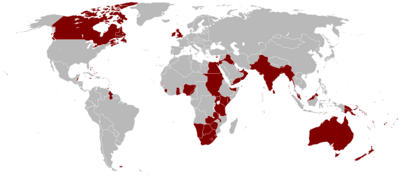
第一次世界大战所带来的世界格局的变化,尤其是美利坚合众国和大日本帝国作为新一代海权国家的崛起,以及印度、爱尔兰当地民族主义运动的兴起,使得英国开始重新评估其帝国政策[149]。被迫在美国和日本之间做出抉择的英国政府,最终选择放弃日本作为其盟友的策略,转而接受了与美国在海军方面的对等地位,并于1922年签订了《华盛顿海军条约》 [150]。而在30年代,随着日本和德国在大萧条中逐渐转向军国主义[151],英国国内对于外交政策的方向也产生了大量讨论——令人担忧的是,帝国恐怕难以同时面对这两个国家的攻击[152]。帝国的生存,对于英国是至关重要的问题,因为它影响着英国的经济[153]。
1919年,由于爱尔兰自治运动被推迟,在1918年英国大选中取得大多数爱尔兰席位的新芬党在都柏林宣布成立议会,并声称将脱离英国。与此同时,爱尔兰共和军对英国政府发动了游击战[154],但是这场战争于1921年以僵局结束,双方签订了英爱条约,宣告爱尔兰自由邦的成立,爱尔兰将被赋予自治领地位,地位仍在联合王国之下,但是能够拥有自行处理外交、国防事务的权力[155]。由六个郡组成的北爱尔兰,则运用其在《1920年爱尔兰政府法》中取得的权力,选择继续留在英国内部[156]。
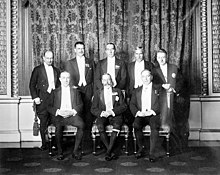
《1919年印度政府法案》没能满足印度人对独立的追求[157]。加达尔兵变阴谋之后,英国政府发现在印度维持镇压是有必要的,并因此实施了《1919年无政府主义与革命罪行法》。该法案一经实施便激化了印度社会的矛盾[158],尤其是在旁遮普地区,英属印度当局的镇压导致了阿姆利则惨案的发生。英国本土舆论对于惨案的评价两极分化,一些人认为政府是在保护当地社会免于堕入无政府主义者之手,另一些人则对大屠杀表示反感[158]。1922年乔里-乔拉事件后,不合作运动也被当局叫停,而在此后的25年间,不满一直在当地人心中滋长[159]。
1922年,自第一次世界大战爆发起一直处于英国保护之下的埃及被赋予独立地位,尽管如此,埃及还是作为英国的附庸国直至1954年,直到1936年双方订立英埃条约后,约定英国仍享有对苏伊士运河的驻兵权后,英国陆军的驻军才撤离埃及[160]。作为回报,埃及将被接纳进入国际联盟[161]。英国的托管地伊拉克直到1932年独立后才加入国联[162]。在巴勒斯坦,英国需要调解当地阿拉伯人与不断涌入的犹太人之间日益加深的矛盾。1917年,时任英国外相阿瑟·贝尔福发表宣言,声称将为“犹太人在巴勒斯坦内建立一个民族之家”,而且犹太人将得以在巴勒斯坦托管国的规范下移民该地[163]。该宣言导致中东地区在接下来的时间里持续动荡,而犹太复国主义分子公然无视宣言中“不得伤害其他本地民族利益”的条款,大肆排挤阿拉伯族群,也使得当地阿拉伯人不满日增,并最终于1936年发动暴乱。待到三十年代,随着来自德国的威胁与日俱增,英国政府为了争取阿拉伯世界的支持,逐渐转向亲阿拉伯立场,限制犹太人移民至巴勒斯坦,而这又导致了犹太人暴动[143]。
1923年帝国会议授予了各自治领独立处理外交事务的权利[164]。不过在此前查纳克危机爆发时,加拿大和南非联邦就拒绝了英国的增兵请求,而加拿大也拒绝为《洛桑条约》所约束[165]。继爱尔兰自由邦和南非联邦向英国施压后,1926年召开的帝国会议通过了《1926年贝尔福宣言》宣布各自治领“都是大英帝国内部的自治社区,彼此平等,互不隶属,共同属于英联邦”[166]。《1931年威斯敏斯特法令》颁布后,该宣言的精神正式在法律层面上成为现实[136]。从法理上讲,自该法令后,加拿大、澳大利亚、新西兰、南非联邦、爱尔兰自由邦和纽芬兰自治领都将脱离英国控制,她们可以废除英国法律,而英国议会在未经许可的情况下无权为她们立法[167]。此后,纽芬兰囿于大萧条所带来的经济崩溃,被重新降格为殖民地[168]。而爱尔兰自由邦在于1937年通过其共和宪法后亦更名为爱尔兰[169]。
第二次世界大战
[编辑]
1939年9月3日,英国对德意志国宣战,其在宣战声明中亦代表了英属印度和各直辖殖民地,不过依据《1931年威斯敏斯特法规》,各自治领有权自行行使国防和外交权利。各自治领亦步亦趋,相继参与对德作战。然而,尽管英国仍将爱尔兰视为英联邦的一份子,爱尔兰还是选择在整场战争期间维持中立[170]。
自1940年6月法国与德国停战后,英国独立支撑全局,直到1941年4月7日德国入侵希腊。战时内阁首相温斯顿·丘吉尔成功游说时任美国总统弗兰克林·德拉诺·罗斯福为英国提供援助——尽管当时罗斯福并没有准备请求国会宣布参战[171]。1941年8月,丘吉尔与罗斯福会晤并签署了《大西洋宪章》,声称“尊重所有民族选择他们愿意生活于其下的政府形式之权利”,这句话当中指代对象的不明确也使得后来的英国、美国和各地区民族主义运动对其各执一词[172][173]。
对于丘吉尔而言,美国参战的消息可以说是“极大的宽慰”[174]。他认为英国终将胜利[175],但是没能认识到在取得最终胜利前“还有诸多灾难,需要付出极大的代价才能实现”[176]而战争也将对大英帝国的未来产生永久的影响。英国在远东迅速而惨痛的军事失败,尤其是在被视为“东方直布罗陀”的新加坡沦陷后,其作为全球列强的国际地位与威信受到了难以逆转的影响[177][178][179]。而澳大利亚和新西兰,在发现英国难以在日军步步紧逼之下保全其帝国后,逐渐转向同美国合作,并最终在1951年订立《太平洋安全保障条约》[172]。战争还在其它方面削弱了帝国,在印度,帝国的统治为日本的迅速推进而动摇;在本土,战争对英国的经济造成了长期的负面影响。随着英国的世界霸主地位逐渐让位于美国和苏联,旧有的地缘政治格局自此被改变[180]。
1945–1992年:去殖民化运动与陨落
[编辑]Though Britain and the empire emerged victorious from the Second World War, the effects of the conflict were profound, both at home and abroad. Much of Europe, a continent that had dominated the world for several centuries, was in ruins, and host to the armies of the United States and the Soviet Union, who now held the balance of global power.[181] Britain was left essentially bankrupt, with insolvency only averted in 1946 after the negotiation of a $US 4.33 billion loan from the United States,[182] the last installment of which was repaid in 2006.[183] At the same time, anti-colonial movements were on the rise in the colonies of European nations. The situation was complicated further by the increasing Cold War rivalry of the United States and the Soviet Union. In principle, both nations were opposed to European colonialism. In practice, American anti-communism prevailed over anti-imperialism, and therefore the United States supported the continued existence of the British Empire to keep Communist expansion in check.[184] At first British politicians believed it would be possible to maintain Britain's role as a world power at the head of a re-imagined Commonwealth,[185] but by 1960 they were forced to recognise that there was an irresistible "wind of change" blowing. Their priorities changed to maintaining an extensive zone of British influence[186] and ensuring that stable, non-Communist governments were established in former colonies. In this context, while other European powers such as France and Portugal[187] waged costly and unsuccessful wars to keep their empires intact, Britain generally adopted a policy of peaceful disengagement from its colonies. In reality, this was rarely peaceable or altruistic. Between 1945 and 1965, the number of people under British rule outside the UK itself fell from 700 million to 5 million, 3 million of whom were in Hong Kong.[188]
首波脱离
[编辑]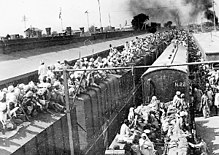
The pro-decolonisation Labour government, elected at the 1945 general election and led by Clement Attlee, moved quickly to tackle the most pressing issue facing the empire: Indian independence.[189] India's two major political parties—the Indian National Congress (led by Mahatma Gandhi) and the Muslim League (led by Muhammad Ali Jinnah)—had been campaigning for independence for decades, but disagreed as to how it should be implemented. Congress favoured a unified secular Indian state, whereas the League, fearing domination by the Hindu majority, desired a separate Islamic state for Muslim-majority regions. Increasing civil unrest and the mutiny of the Royal Indian Navy during 1946 led Attlee to promise independence no later than 30 June 1948. When the urgency of the situation and risk of civil war became apparent, the newly appointed (and last) Viceroy, Lord Mountbatten, hastily brought forward the date to 15 August 1947.[190] The borders drawn by the British to broadly partition India into Hindu and Muslim areas left tens of millions as minorities in the newly independent states of India and Pakistan.[191] Millions of Muslims crossed from India to Pakistan and Hindus vice versa, and violence between the two communities cost hundreds of thousands of lives. Burma, which had been administered as part of the British Raj, and Sri Lanka gained their independence the following year in 1948. India, Pakistan and Sri Lanka became members of the Commonwealth, while Burma chose not to join.[192]
The British Mandate in Palestine, where an Arab majority lived alongside a Jewish minority, presented the British with a similar problem to that of India.[193] The matter was complicated by large numbers of Jewish refugees seeking to be admitted to Palestine following the Holocaust, while Arabs were opposed to the creation of a Jewish state. Frustrated by the intractability of the problem, attacks by Jewish paramilitary organisations and the increasing cost of maintaining its military presence, Britain announced in 1947 that it would withdraw in 1948 and leave the matter to the United Nations to solve.[194] The UN General Assembly subsequently voted for a plan to partition Palestine into a Jewish and an Arab state. It was immediately followed by the outbreak of a civil war between the Arabs and Jews of Palestine, and British forces withdrew amid the fighting. The British Mandate for Palestine officially terminated at midnight on 15 May 1948 as the State of Israel declared independence and the 1948 Arab-Israeli War broke out, during which the territory of the former Mandate was partitioned between Israel and the surrounding Arab states. Amid the fighting, British forces continued to withdraw from Israel, with the last British troops departing from Haifa on 30 June 1948.[195]
Following the surrender of Japan in the Second World War, anti-Japanese resistance movements in Malaya turned their attention towards the British, who had moved to quickly retake control of the colony, valuing it as a source of rubber and tin.[196] The fact that the guerrillas were primarily Malayan-Chinese Communists meant that the British attempt to quell the uprising was supported by the Muslim Malay majority, on the understanding that once the insurgency had been quelled, independence would be granted.[196] The Malayan Emergency, as it was called, began in 1948 and lasted until 1960, but by 1957, Britain felt confident enough to grant independence to the Federation of Malaya within the Commonwealth. In 1963, the 11 states of the federation together with Singapore, Sarawak and North Borneo joined to form Malaysia, but in 1965 Chinese-majority Singapore was expelled from the union following tensions between the Malay and Chinese populations and became an independent city-state.[197] Brunei, which had been a British protectorate since 1888, declined to join the union.[198]
第二次中东战争
[编辑]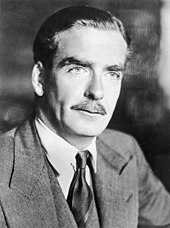
In 1951, the Conservative Party returned to power in Britain, under the leadership of Winston Churchill. Churchill and the Conservatives believed that Britain's position as a world power relied on the continued existence of the empire, with the base at the Suez Canal allowing Britain to maintain its pre-eminent position in the Middle East in spite of the loss of India. Churchill could not ignore Gamal Abdul Nasser's new revolutionary government of Egypt that had taken power in 1952, and the following year it was agreed that British troops would withdraw from the Suez Canal zone and that Sudan would be granted self-determination by 1955, with independence to follow.[199] Sudan was granted independence on 1 January 1956.[200]
In July 1956, Nasser unilaterally nationalised the Suez Canal. The response of Anthony Eden, who had succeeded Churchill as Prime Minister, was to collude with France to engineer an Israeli attack on Egypt that would give Britain and France an excuse to intervene militarily and retake the canal.[201] Eden infuriated US President Dwight D. Eisenhower by his lack of consultation, and Eisenhower refused to back the invasion.[202] Another of Eisenhower's concerns was the possibility of a wider war with the Soviet Union after it threatened to intervene on the Egyptian side. Eisenhower applied financial leverage by threatening to sell US reserves of the British pound and thereby precipitate a collapse of the British currency.[203] Though the invasion force was militarily successful in its objectives,[204] UN intervention and US pressure forced Britain into a humiliating withdrawal of its forces, and Eden resigned.[205][206]
The Suez Crisis very publicly exposed Britain's limitations to the world and confirmed Britain's decline on the world stage and its end as a first-rate power,[207][208] demonstrating that henceforth it could no longer act without at least the acquiescence, if not the full support, of the United States.[209][210][211] The events at Suez wounded British national pride, leading one Member of Parliament (MP) to describe it as "Britain's Waterloo"[212] and another to suggest that the country had become an "American satellite".[213] Margaret Thatcher later described the mindset she believed had befallen Britain's political leaders after Suez where they "went from believing that Britain could do anything to an almost neurotic belief that Britain could do nothing", from which Britain did not recover until the successful recapture of the Falkland Islands from Argentina in 1982.[214]
While the Suez Crisis caused British power in the Middle East to weaken, it did not collapse.[215] Britain again deployed its armed forces to the region, intervening in Oman (1957), Jordan (1958) and Kuwait (1961), though on these occasions with American approval,[216] as the new Prime Minister Harold Macmillan's foreign policy was to remain firmly aligned with the United States.[212] Although Britain granted Kuwait independence in 1961, it continued to maintain a military presence in the Middle East for another decade. On 16 January 1968, a few weeks after the devaluation of the pound, Prime Minister Harold Wilson and his Defence Secretary Denis Healey announced that British troops would be withdrawn from major military bases East of Suez, which included the ones in the Middle East, and primarily from Malaysia and Singapore by the end of 1971, instead of 1975 as earlier planned.[217] By that time over 50,000 British military personnel were still stationed in the Far East, including 30,000 in Singapore.[218] The British granted independence to the Maldives in 1965 but continued to station a garrison there until 1976, withdrew from Aden in 1967, and granted independence to Bahrain, Qatar, and the United Arab Emirates in 1971.[219]
风云变幻
[编辑]
Macmillan gave a speech in Cape Town, South Africa in February 1960 where he spoke of "the wind of change blowing through this continent".[220] Macmillan wished to avoid the same kind of colonial war that France was fighting in Algeria, and under his premiership decolonisation proceeded rapidly.[221] To the three colonies that had been granted independence in the 1950s—Sudan, the Gold Coast and Malaya—were added nearly ten times that number during the 1960s.[222]
Britain's remaining colonies in Africa, except for self-governing Southern Rhodesia, were all granted independence by 1968. British withdrawal from the southern and eastern parts of Africa was not a peaceful process. Kenyan independence was preceded by the eight-year Mau Mau uprising, in which tens of thousands of suspected rebels were interned by the colonial government in detention camps.[223] In Rhodesia, the 1965 Unilateral Declaration of Independence by the white minority resulted in a civil war that lasted until the Lancaster House Agreement of 1979, which set the terms for recognised independence in 1980, as the new nation of Zimbabwe.[224]
在賽普勒斯的希臘裔賽普勒斯人建立起賽普勒斯戰士全國組織(EOKA)並發動反對英國統治的遊擊戰,因1959年《倫敦-蘇黎世條約》的簽訂而結束,隔年賽普勒斯獨立。但英國保留亞克羅提利與德凱利亞地區的軍事基地。「馬爾他直轄殖民地」原本於1955年提出在1956年2月11日至12日舉行與英國合併的公投中,但最後合併案並未成功,於1964年獨立成馬爾他共和國。[225]
Most of the UK's Caribbean territories achieved independence after the departure in 1961 and 1962 of Jamaica and Trinidad from the West Indies Federation, established in 1958 in an attempt to unite the British Caribbean colonies under one government, but which collapsed following the loss of its two largest members.[226] Jamaica attained independence in 1962, as did Trinidad and Tobago. Barbados achieved independence in 1966 and the remainder of the eastern Caribbean islands, including the Bahamas, in the 1970s and 1980s,[226] but Anguilla and the Turks and Caicos Islands opted to revert to British rule after they had already started on the path to independence.[227] The British Virgin Islands,[228] The Cayman Islands and Montserrat opted to retain ties with Britain,[229] while Guyana achieved independence in 1966. Britain's last colony on the American mainland, British Honduras, became a self-governing colony in 1964 and was renamed Belize in 1973, achieving full independence in 1981. A dispute with Guatemala over claims to Belize was left unresolved.[230]
British territories in the Pacific acquired independence in the 1970s beginning with Fiji in 1970 and ending with Vanuatu in 1980. Vanuatu's independence was delayed because of political conflict between English and French-speaking communities, as the islands had been jointly administered as a condominium with France.[231] Fiji, Papua New Guinea, Solomon Islands and Tuvalu became Commonwealth realms.[232]
帝国终结
[编辑]By 1981, aside from a scattering of islands and outposts, the process of decolonisation that had begun after the Second World War was largely complete. In 1982, Britain's resolve in defending its remaining overseas territories was tested when Argentina invaded the Falkland Islands, acting on a long-standing claim that dated back to the Spanish Empire.[233] Britain's successful military response to retake the islands during the ensuing Falklands War contributed to reversing the downward trend in Britain's status as a world power.[234]
The 1980s saw Canada, Australia, and New Zealand sever their final constitutional links with Britain. Although granted legislative independence by the Statute of Westminster 1931, vestigial constitutional links had remained in place. The British Parliament retained the power to amend key Canadian constitutional statutes, meaning that effectively an act of the British Parliament was required to make certain changes to the Canadian Constitution.[235] The British Parliament had the power to pass laws extending to Canada at Canadian request. Although no longer able to pass any laws that would apply as Australian Commonwealth law, the British Parliament retained the power to legislate for the individual Australian states. With regard to New Zealand, the British Parliament retained the power to pass legislation applying to New Zealand with the New Zealand Parliament's consent. In 1982, the last legal link between Canada and Britain was severed by the Canada Act 1982, which was passed by the British parliament, formally patriating the Canadian Constitution. The act ended the need for British involvement in changes to the Canadian constitution.[12] Similarly, the Australia Act 1986 (effective 3 March 1986) severed the constitutional link between Britain and the Australian states, while New Zealand's Constitution Act 1986 (effective 1 January 1987) reformed the constitution of New Zealand to sever its constitutional link with Britain.[236]
On 1 January 1984, Brunei, Britain's last remaining Asian protectorate, was granted independence.[237] Independence had been delayed due to the opposition of the Sultan, who had preferred British protection.[238]
In September 1982 the Prime Minister, Margaret Thatcher, travelled to Beijing to negotiate with the Chinese government, on the future of Britain's last major and most populous overseas territory, Hong Kong.[239] Under the terms of the 1842 Treaty of Nanking and 1860 Convention of Peking, Hong Kong Island and Kowloon Peninsula had been respectively ceded to Britain in perpetuity, but the majority of the colony consisted of the New Territories, which had been acquired under a 99-year lease in 1898, due to expire in 1992.[240][241] Thatcher, seeing parallels with the Falkland Islands, initially wished to hold Hong Kong and proposed British administration with Chinese sovereignty, though this was rejected by China.[242] A deal was reached in 1984—under the terms of the Sino-British Joint Declaration, Hong Kong would become a special administrative region of the People's Republic of China, maintaining its way of life for at least 50 years.[243] The handover ceremony in 1992 marked for many,[11] including Charles, Prince of Wales, who was in attendance, "the end of Empire".[12]
影响
[编辑]
Britain retains sovereignty over 14 territories outside the British Isles. In 1983, the British Nationality Act 1981 renamed the existing Crown Colonies as "British Dependent Territories",[註 1] and in 2002 they were renamed the British Overseas Territories.[246] Most former British colonies and protectorates are members of the Commonwealth of Nations, a voluntary association of equal members, comprising a population of around 2.2 billion people.[247] Fifteen Commonwealth realms voluntarily continue to share the British monarch, Queen Elizabeth II, as their head of state. These fifteen nations are distinct and equal legal entities – the United Kingdom, Australia, Canada, New Zealand, Antigua and Barbuda, The Bahamas, Belize, Grenada, Jamaica, Papua New Guinea, Saint Kitts and Nevis, Saint Lucia, Saint Vincent and the Grenadines, Solomon Islands and Tuvalu.[248]
Decades, and in some cases centuries, of British rule and emigration have left their mark on the independent nations that arose from the British Empire. The empire established the use of the English language in regions around the world. Today it is the primary language of up to 460 million people and is spoken by about 1.5 billion as a first, second or foreign language.[249] Individual and team sports developed in Britain; particularly football, cricket, lawn tennis, and golf were exported.[250] British missionaries who travelled around the globe often in advance of soldiers and civil servants spread Protestantism (including Anglicanism) to all continents. The British Empire provided refuge for religiously persecuted continental Europeans for hundreds of years.[251]

Political boundaries drawn by the British did not always reflect homogeneous ethnicities or religions, contributing to conflicts in formerly colonised areas. The British Empire was responsible for large migrations of peoples. Millions left the British Isles, with the founding settler populations of the United States, Canada, Australia and New Zealand coming mainly from Britain and Ireland. Tensions remain between the white settler populations of these countries and their indigenous minorities, and between white settler minorities and indigenous majorities in South Africa and Zimbabwe. Settlers in Ireland from Great Britain have left their mark in the form of divided nationalist and unionist communities in Northern Ireland. Millions of people moved to and from British colonies, with large numbers of Indians emigrating to other parts of the empire, such as Malaysia and Fiji, and Chinese people to Malaysia, Singapore and the Caribbean.[252] The demographics of Britain itself were changed after the Second World War owing to immigration to Britain from its former colonies.[253]
In the 19th century, innovation in Britain led to revolutionary changes in manufacturing, the development of factory systems, and the growth of transportation by railway and steam ship.[254] British colonial architecture, such as in churches, railway stations and government buildings, can be seen in many cities that were once part of the British Empire.[255] The British choice of system of measurement, the imperial system, continues to be used in some countries in various ways. The convention of driving on the left hand side of the road has been retained in much of the former empire.[256]
The Westminster system of parliamentary democracy has served as the template for the governments for many former colonies,[257][258] and English common law for legal systems.[259] International commercial contracts are often based on English common law.[260] The British Judicial Committee of the Privy Council still serves as the highest court of appeal for twelve former colonies.[261]
注释
[编辑]- ^ Schedule 6 of the British Nationality Act 1981[244] reclassified the remaining Crown colonies as "British Dependent Territories". The Act entered into force on 1 January 1983[245]
参见
[编辑]
脚注
[编辑]- ^ Ferguson 2004b.
- ^ Maddison 2001, p. 97: "The total population of the Empire was 412 million [in 1913]"; Maddison 2001, pp. 241: "[World population in 1913 (in thousands):] 1 791 020".
- ^ Taagepera, p. 502.
- ^ Jackson, pp. 5–6.
- ^ Russo 2012, p. 15 chapter 1 'Great Expectations': "The dramatic rise in Spanish fortunes sparked both envy and fear among northern, mostly Protestant, Europeans.".
- ^ Dutch Maritime Power and the Colonial Status Quo, 1585‑1641 • PacHR 11:29‑41 (1942). penelope.uchicago.edu. [2023-08-08].
- ^ Harding, Richard. The Emergence of Britain's Global Naval Supremacy. Boydell and Brewer Limited. 2010-11-18. ISBN 978-1-84615-906-0.
- ^ http://www.zxls.com/UploadFiles/2021/3/%E7%BE%8E%E5%9B%BD%E7%8B%AC%E7%AB%8B%E6%88%98%E4%BA%89%E5%AF%B9%E8%8B%B1%E6%B3%95%E4%BA%89%E9%9C%B8%E7%9A%84%E5%BD%B1%E5%93%8D_%E7%8E%8B%E6%99%93%E8%BE%89_2021322222455.pdf
- ^ 9.0 9.1 Porter, p. 8.
- ^ 10.0 10.1 Marshall, pp. 156–57.
- ^ 11.0 11.1 Brendon, p. 660.
- ^ 12.0 12.1 12.2 Brown, p. 594.
- ^ 13.0 13.1 Ferguson 2004b,第3頁.
- ^ Ferguson 2004b,第4頁.
- ^ Koebner, pp. 29–52.
- ^ Canny, p. 35.
- ^ Thomas, pp. 155–58
- ^ Canny, p. 62.
- ^ Lloyd, pp. 4–8.
- ^ Canny, p. 7.
- ^ Kenny, p. 5.
- ^ Taylor, pp. 119,123.
- ^ Letters Patent to Sir Humfrey Gylberte June 11, 1578. Avalon Project. [2021-02-08].
- ^ Andrews, p. 187.
- ^ Andrews, p. 188.
- ^ Canny, p. 63.
- ^ Canny, pp. 63–64.
- ^ Canny, p. 70.
- ^ Canny, p. 34.
- ^ James, p. 17.
- ^ Canny, p. 71.
- ^ Canny, p. 221.
- ^ Lloyd, pp. 22–23.
- ^ Lloyd, p. 32.
- ^ Lloyd, pp. 33, 43.
- ^ Lloyd,pp. 15–20.
- ^ Andrews, pp. 316, 324–26.
- ^ Andrews, pp. 20–22.
- ^ James, p. 8.
- ^ Lloyd, p. 40.
- ^ Ferguson 2004b,第72–73頁.
- ^ 42.0 42.1 42.2 Buckner, p. 25.
- ^ Lloyd, p. 37.
- ^ Ferguson 2004b,第62頁.
- ^ Canny, p. 228.
- ^ Marshall, pp. 440–64.
- ^ Lloyd, p. 13.
- ^ 48.0 48.1 Ferguson 2004b,第19頁.
- ^ Canny, p. 441.
- ^ 50.0 50.1 50.2 Shennan, pp. 11–17.
- ^ Magnusson, p. 531.
- ^ Macaulay, p. 509.
- ^ Pagden, p. 90.
- ^ James, p. 58.
- ^ Anderson, p. 277.
- ^ Smith, p. 17.
- ^ Bandyopādhyāẏa, pp. 49–52
- ^ Smith, pp. 18–19.
- ^ 59.0 59.1 Pagden, p. 91.
- ^ Marshall, pp. 312–23.
- ^ Canny, p. 92.
- ^ James, p. 120.
- ^ James, p. 119.
- ^ Marshall, p. 585.
- ^ Zolberg, p. 496.
- ^ Games, pp. 46–48.
- ^ Kelley & Trebilcock, p. 43.
- ^ Smith, p. 28.
- ^ Latimer, pp. 8, 30–34, 389–92.
- ^ Marshall, pp. 388.
- ^ Smith, p. 20.
- ^ Smith, pp. 20–21.
- ^ Mulligan & Hill, pp. 20–23.
- ^ Peters, pp. 5–23.
- ^ James, p. 142.
- ^ Macintyre, pp. 33–34.
- ^ Broome, p. 18.
- ^ Pascoe
- ^ McKenna, pp. 28–29.
- ^ Brock, p. 159.
- ^ Fieldhouse, pp. 145–49
- ^ Cervero, p. 320
- ^ Smith, p. 45.
- ^ Waitangi Day. nzhistory.govt.nz. New Zealand Ministry for Culture and Heritage. [2008-12-13]. (原始内容存档于2008-12-20).
- ^ Porter, p. 579.
- ^ Mein Smith, p. 49.
- ^ James, p. 152.
- ^ James, p. 151.
- ^ Lloyd, pp. 115–118.
- ^ James, p. 165.
- ^ Why was Slavery finally abolished in the British Empire?. The Abolition Project. [2016-12-31]. (原始内容存档于2016-11-26).
- ^ Porter, p. 14.
- ^ Hinks, p. 129.
- ^ Slavery After 1807. Historic England. [2019-11-24] (英语).
As a result of public pressure apprenticeships were abolished early, in 1838.
- ^ Slavery Abolition Act 1833; Section XXIV. pdavis. 1833-08-28 [2008-06-03].
- ^ Sanchez Manning. Britain's colonial shame: Slave-owners given huge payouts after. The Independent. 2013-02-24 [2018-02-11].
- ^ Hyam, p. 1.
- ^ Smith, p. 71.
- ^ Parsons, p. 3.
- ^ 100.0 100.1 Porter, p. 401.
- ^ Lee 1994, pp. 254–57.
- ^ Porter, p. 332.
- ^ Johnston, pp. 508–10.
- ^ Sondhaus, p. 9.
- ^ Dalziel, pp. 88–91.
- ^ Mori, p. 178.
- ^ Martin, pp. 146–48.
- ^ Janin, p. 28.
- ^ Keay, p. 393
- ^ Parsons, pp. 44–46.
- ^ Smith, pp. 50–57.
- ^ Brown, p. 5.
- ^ Marshall, pp. 133–34.
- ^ Hopkirk, pp. 1–12.
- ^ James, p. 181.
- ^ 116.0 116.1 116.2 James, p. 182.
- ^ Royle, preface.
- ^ Williams, pp. 360–373.
- ^ Hodge, p. 47.
- ^ Smith, p. 85.
- ^ Smith, pp. 85–86.
- ^ Lloyd, pp. 168, 186, 243.
- ^ Lloyd, p. 255.
- ^ Tilby, p. 256.
- ^ Roger 1986, p. 718.
- ^ Ferguson 2004b,第230–33頁.
- ^ James, p. 274.
- ^ Treaties. Egypt Ministry of Foreign Affairs. [2010-10-20]. (原始内容存档于2010-09-15).
- ^ Herbst, pp. 71–72.
- ^ Vandervort, pp. 169–83.
- ^ James, p. 298.
- ^ Lloyd, p. 215.
- ^ Smith, pp. 28–29.
- ^ Porter, p. 187
- ^ Smith, p. 30.
- ^ 136.0 136.1 Rhodes, Wanna & Weller, pp. 5–15.
- ^ Lloyd, p. 213
- ^ 138.0 138.1 James, p. 315.
- ^ Smith, p. 92.
- ^ O'Brien, p. 1.
- ^ Brown, p. 667.
- ^ Lloyd, p. 275.
- ^ 143.0 143.1 Brown, pp. 494–95.
- ^ Marshall, pp. 78–79.
- ^ Lloyd, p. 277.
- ^ Lloyd, p. 278.
- ^ Ferguson 2004b,第315頁.
- ^ Fox, pp. 23–29, 35, 60.
- ^ Goldstein, p. 4.
- ^ Louis, p. 302.
- ^ Louis, p. 294.
- ^ Louis, p. 303.
- ^ Lee 1996, p. 305.
- ^ Brown, p. 143.
- ^ Smith, p. 95.
- ^ Magee, p. 108.
- ^ Ferguson 2004b,第330頁.
- ^ 158.0 158.1 James, p. 416.
- ^ Low, pp. 241–259.
- ^ Smith, p. 104.
- ^ Brown, p. 292.
- ^ Smith, p. 101.
- ^ Louis, p. 271.
- ^ McIntyre, p. 187.
- ^ McIntyre, p. 186.
- ^ Brown, p. 69.
- ^ Turpin & Tomkins, p. 48.
- ^ Lloyd, p. 300.
- ^ Galligan, p. 122.
- ^ Lloyd, pp. 313–14.
- ^ Gilbert, p. 234.
- ^ 172.0 172.1 Lloyd, p. 316.
- ^ James, p. 513.
- ^ Churchill, p. 539.
- ^ Gilbert, p. 244.
- ^ Churchill, p. 540.
- ^ Louis, p. 337.
- ^ Brown, p. 319.
- ^ James, p. 460.
- ^ Darwin, p. 340.
- ^ Abernethy, p. 146.
- ^ Brown, p. 331.
- ^ What's a little debt between friends?. BBC News. 2006-05-10 [2008-11-20]. (原始内容存档于2010-06-10).
- ^ Levine, p. 193.
- ^ Darwin, p. 343.
- ^ Darwin, p. 366.
- ^ Abernethy, p. 148.
- ^ Brown, p. 330.
- ^ Lloyd, p. 322.
- ^ Smith, p. 67.
- ^ Lloyd, p. 325.
- ^ McIntyre, pp. 355–356.
- ^ Lloyd, p. 327.
- ^ Lloyd, p. 328.
- ^ The British Army in Palestine. National Army Museum. [2019-06-25]. (原始内容存档于2019-06-29).
- ^ 196.0 196.1 Lloyd, p. 335.
- ^ Lloyd, p. 364.
- ^ Lloyd, p. 396.
- ^ Brown, pp. 339–40.
- ^ James, p. 572.
- ^ James, p. 581.
- ^ Ferguson 2004b,第355頁.
- ^ Ferguson 2004b,第356頁.
- ^ James, p. 583.
- ^ Combs, pp. 161–63.
- ^ Suez Crisis: Key players. BBC News. 2006-07-21 [2010-10-19]. (原始内容存档于2012-02-04).
- ^ Brown, Derek. 1956: Suez and the end of empire. The Guardian. 2001-03-14 [2018-12-19]. (原始内容存档于2018-12-19).
- ^ Reynolds, Paul. Suez: End of empire. BBC News. 2006-07-24 [2018-12-19]. (原始内容存档于2017-08-30).
- ^ Brown, p. 342.
- ^ Smith, p. 105.
- ^ Burk, p. 602.
- ^ 212.0 212.1 Brown, p. 343.
- ^ James, p. 585.
- ^ An affair to remember. The Economist. 2006-07-27 [2016-06-25]. ISSN 0013-0613. (原始内容存档于2016-05-08).
- ^ Smith, p. 106.
- ^ James, p. 586.
- ^ Pham 2010
- ^ Gurtov, p. 42.
- ^ Lloyd, pp. 370–71.
- ^ James, p. 616.
- ^ Louis, p. 46.
- ^ Lloyd, pp. 427–33.
- ^ Zane, Damian. The Kenyan school where the UK held Mau Mau rebels. 2019-08-27 [2019-11-24] (英国英语).
- ^ James, pp. 618–21.
- ^ Springhall, pp. 100–02.
- ^ 226.0 226.1 Knight & Palmer, pp. 14–15.
- ^ Clegg, p. 128.
- ^ Lloyd, p. 428.
- ^ James, p. 622.
- ^ Lloyd, pp. 401, 427–29.
- ^ Macdonald, pp. 171–91.
- ^ McIntyre, p. 35.
- ^ James, pp. 624–25.
- ^ James, p. 629.
- ^ Gérin-Lajoie
- ^ Brown, p. 689.
- ^ Trumbull, Robert. Borneo Sultanate Now Independent. The New York Times. 1984-01-01 [2020-07-15].
- ^ Brown, p. 202.
- ^ Brendon, p. 654.
- ^ Joseph, p. 355.
- ^ Rothermund, p. 100.
- ^ Brendon, pp. 654–55.
- ^ Brendon, p. 656.
- ^ British Nationality Act 1981, Schedule 6. legislation.gov.uk. [2019-03-18]. (原始内容存档于2019-04-01).
- ^ The British Nationality Act 1981 (Commencement) Order 1982. legislation.gov.uk. [2019-03-18]. (原始内容存档于2019-04-01).
- ^ Gapes, pp. 145–47
- ^ The Commonwealth – About Us 互联网档案馆的存檔,存档日期2013-09-27.; Online September 2014
- ^ Head of the Commonwealth. Commonwealth Secretariat. [2010-10-09]. (原始内容存档于2010-07-06).
- ^ Hogg, p. 424 chapter 9 English Worldwide by David Crystal: "approximately one in four of the worlds population are capable of communicating to a useful level in English".
- ^ Torkildsen, p. 347.
- ^ Pestan, p. 185.
- ^ Marshall, p. 286.
- ^ Dalziel, p. 135.
- ^ Walker, pp. 187–188.
- ^ Marshall, pp. 238–40.
- ^ Parsons, p. 1.
- ^ Go, pp. 92–94.
- ^ How the Westminster Parliamentary System was exported around the World. University of Cambridge. 2013-12-02 [2013-12-16].
- ^ Ferguson 2004b,第307頁.
- ^ Cuniberti, p. 455.
- ^ Young, p. 20.
参考文献
[编辑]- Abernethy, David. The Dynamics of Global Dominance, European Overseas Empires 1415–1980. Yale University Press. 2000 [2009-07-22]. ISBN 978-0-300-09314-8.
- Anderson, Adam; Combe, William. An Historical and Chronological Deduction of the Origin of Commerce, from the Earliest Accounts. J Archer. 1801.
- Andrews, Kenneth. Trade, Plunder and Settlement: Maritime Enterprise and the Genesis of the British Empire, 1480–1630
 . Cambridge University Press. 1984 [2009-07-22]. ISBN 978-0-521-27698-6.
. Cambridge University Press. 1984 [2009-07-22]. ISBN 978-0-521-27698-6. - Bandyopādhyāẏa, Śekhara. From Plassey to partition: a history of modern India. Orient Longman. 2004. ISBN 978-81-250-2596-2.
- Brendon, Piers. The Decline and Fall of the British Empire, 1781–1997. Random House. 2007. ISBN 978-0-224-06222-0.
- Brock, W.R. Britain and the Dominions. Cambridge University Press. 2011. ISBN 9781107688339.
- Broome, Richard. Aboriginal Australians: A history since 1788. Allen & Unwin. 2010. ISBN 978-1-74176-554-0.
- Brown, D. E. Brunei on the Morrow of Independence. Far Eastern Survey. 1984-02-01, 24 (2): 201–208 [2011-11-15]. JSTOR 2644439. doi:10.2307/2644439.
- Brown, Judith. The Twentieth Century, The Oxford History of the British Empire Volume IV. Oxford University Press. 1998 [2009-07-22]. ISBN 978-0-19-924679-3.
- Louis, Roger. The British Empire in the Middle East, 1945–1951: Arab Nationalism, the United States, and Postwar Imperialism. Oxford University Press. 1986 [2012-08-24]. ISBN 978-0-19-822960-5.
- Buckner, Phillip. Canada and the British Empire. Oxford University Press. 2008 [2009-07-22]. ISBN 978-0-19-927164-1.
- Burk, Kathleen. Old World, New World: Great Britain and America from the Beginning
 . Atlantic Monthly Press. 2008 [2012-01-22]. ISBN 978-0-87113-971-9.
. Atlantic Monthly Press. 2008 [2012-01-22]. ISBN 978-0-87113-971-9. - Canny, Nicholas. The Origins of Empire, The Oxford History of the British Empire Volume I. Oxford University Press. 1998 [2009-07-22]. ISBN 978-0-19-924676-2.
- Cervero, Robert B. The Transit Metropolis: A Global Inquiry. Island Press. 1998. ISBN 978-1-55963-591-2.
- Churchill, Winston. The Second World War, The Grand Alliance, Volume III. Cassell & Co Ltd. 1950. ISBN 978-0-30-492114-0.
- Clegg, Peter. The UK Caribbean Overseas Territories. de Jong, Lammert; Kruijt, Dirk (编). Extended Statehood in the Caribbean. Rozenberg Publishers. 2005. ISBN 978-90-5170-686-4.
- Combs, Jerald A. The History of American Foreign Policy: From 1895
 . M.E. Sharpe. 2008. ISBN 978-0-7656-2056-9.
. M.E. Sharpe. 2008. ISBN 978-0-7656-2056-9. - Cuniberti, Gilles. The International Market for Contracts: The Most Attractive Contract Laws. Nw. J. Int'l L. & Bus. 2014-10-08, 34 (3).
- Dalziel, Nigel. The Penguin Historical Atlas of the British Empire. Penguin. 2006 [2009-07-22]. ISBN 978-0-14-101844-7.
- Darwin, John. Unfinished Empire, The Global Expansion of Britain. Penguin. 2012. ISBN 978-1-846-14089-1.
- David, Saul. The Indian Mutiny. Penguin. 2003 [2009-07-22]. ISBN 978-0-670-91137-0.
- Elkins, Caroline. Imperial Reckoning: The Untold Story of Britain's Gulag in Kenya. Owl Books. 2005. ISBN 978-0-8050-8001-8.
- Ferguson, Niall. Colossus: The Price of America's Empire
 . Penguin. 2004a. ISBN 978-1-59420-013-7.
. Penguin. 2004a. ISBN 978-1-59420-013-7. - Ferguson, Niall. Empire: The Rise and Demise of the British World Order and the Lessons for Global Power. Basic Books. 2004b. ISBN 978-0-465-02329-5.
- Fieldhouse, David Kenneth. The West and the Third World: trade, colonialism, dependence, and development. Blackwell Publishing. 1999. ISBN 978-0-631-19439-2.
- Fox, Gregory H. Humanitarian Occupation. Cambridge University Press. 2008. ISBN 978-0-521-85600-3.
- Galligan, Brian. A Federal Republic: Australia's Constitutional System of Government. Cambridge University Press. 1995. ISBN 9781139084932. doi:10.1017/CBO9781139084932.
- Games, Alison. Armitage, David; Braddick, Michael J , 编. The British Atlantic world, 1500–1800. Palgrave Macmillan. 2002. ISBN 978-0-333-96341-8.
- Gérin-Lajoie, Paul. Constitutional Amendment in Canada. The Canadian Journal of Economics and Political Science (Blackwell Publishing on behalf of Canadian Economics Association). 1951, 17 (6): 389–394. JSTOR 137699. doi:10.2307/137699.
- Gapes, Mike. HC Paper 147-II House of Commons Foreign Affairs Committee: Overseas Territories, Volume II (PDF). The Stationery Office. 2008 [2017-11-21]. ISBN 978-0-215-52150-7.
- Gilbert, Sir Martin. Churchill and America. Simon and Schuster. 2005 [2009-07-22]. ISBN 978-0-7432-9122-4.
- Go, Julian. A Globalizing Constitutionalism?, Views from the Postcolony, 1945-2000. Arjomand, Saïd Amir (编). Constitutionalism and political reconstruction. Brill. 2007. ISBN 978-90-04-15174-1.
- Goldstein, Erik. The Washington Conference, 1921–22: Naval Rivalry, East Asian Stability and the Road to Pearl Harbor. Routledge. 1994 [2009-07-22]. ISBN 978-0-7146-4559-9.
- Goodlad, Graham David. British foreign and imperial policy, 1865–1919. Psychology Press. 2000 [2010-09-18]. ISBN 978-0-415-20338-8.
- Gurtov, Melvin. Southeast Asia Tomorrow. The Johns Hopkins Press. 1970.
- Hendry, Ian; Dickson, Susan. British Overseas Territories Law. Bloomsbury Publishing. 2018-06-14. ISBN 978-1-5099-1871-3 (英语).
- Herbst, Jeffrey Ira. States and power in Africa: comparative lessons in authority and control. Princeton University Press. 2000. ISBN 0-691-01027-7.
- Hinks, Peter. Encyclopedia of antislavery and abolition. Greenwood Publishing Group. 2007 [2010-08-01]. ISBN 978-0-313-33143-5.
- Hodge, Carl Cavanagh. Encyclopedia of the Age of Imperialism, 1800–1914. Greenwood Publishing Group. 2007 [2009-07-22]. ISBN 978-0-313-33404-7.
- Hogg, Richard. A History of the English Language. Cambridge University Press. 2008 [2010-04-13]. ISBN 978-0-521-66227-7.
- Hopkirk, Peter. The Great Game: The Struggle for Empire in Central Asia. Kodansha International. 2002. ISBN 978-4-7700-1703-1.
- Hollowell, Jonathan. Britain Since 1945. Blackwell Publishing. 1992. ISBN 978-0-631-20968-3.
- Hyam, Ronald. Britain's Imperial Century, 1815–1914: A Study of Empire and Expansion. Palgrave Macmillan. 2002 [2009-07-22]. ISBN 978-0-7134-3089-9.
- Jackson, Ashley. The British Empire: A Very Short Introduction. OUP. 2013. ISBN 978-0-19-960541-5.
- James, Lawrence. The Rise and Fall of the British Empire. Abacus. 2001 [2009-07-22]. ISBN 978-0-312-16985-5.
- Janin, Hunt. The India–China opium trade in the nineteenth century. McFarland. 1999. ISBN 978-0-7864-0715-6.
- Johnston, Douglas M.; Reisman, W. Michael. The Historical Foundations of World Order. Martinus Nijhoff Publishers. 2008. ISBN 978-90-474-2393-5.
- Joseph, William A. Politics in China. Oxford University Press. 2010. ISBN 978-0-19-533530-9.
- Keay, John. The Honourable Company. Macmillan Publishing Company. 1991.
- Kelley, Ninette; Trebilcock, Michael. The Making of the Mosaic 2nd. University of Toronto Press. 2010. ISBN 978-0-8020-9536-7.
- Kenny, Kevin. Ireland and the British Empire. Oxford University Press. 2006 [2009-07-22]. ISBN 978-0-19-925184-1.
- Knight, Franklin W.; Palmer, Colin A. The Modern Caribbean. University of North Carolina Press. 1989. ISBN 978-0-8078-1825-1.
- Koebner, Richard. The Imperial Crown of This Realm: Henry VIII, Constantine the Great, and Polydore Vergil. Historical Research. May 1953, 26 (73): 29–52. ISSN 1468-2281. doi:10.1111/j.1468-2281.1953.tb02124.x.
- Latimer, Jon. War with America. Harvard University Press. 2007 [2009-07-22]. ISBN 978-0-674-02584-4.
- Lee, Stephen J. Aspects of British political history, 1815–1914. Routledge. 1994. ISBN 978-0-415-09006-3.
- Lee, Stephen J. Aspects of British political history, 1914–1995. Routledge. 1996. ISBN 978-0-415-13102-5.
- Levine, Philippa. The British Empire: Sunrise to Sunset. Pearson Education Limited. 2007 [2010-08-19]. ISBN 978-0-582-47281-5.
- Lloyd, Trevor Owen. The British Empire 1558–1995. Oxford University Press. 1996 [2009-07-22]. ISBN 978-0-19-873134-4.
- Louis, Wm. Roger. Ends of British Imperialism: The Scramble for Empire, Suez and Decolonization. I.B. Tauris. 2006 [2009-07-22]. ISBN 978-1-84511-347-6.
- Low, D.A. The Government of India and the First Non-Cooperation Movement – 1920–1922. The Journal of Asian Studies. February 1966, 25 (2): 241–259. JSTOR 2051326. doi:10.2307/2051326.
- Macaulay, Thomas. The History of England from the Accession of James the Second. Penguin. 1848. ISBN 978-0-14-043133-9.
- Macdonald, Barrie. Britain. Howe, K.R.; Kiste, Robert C.; Lal, Brij V (编). Tides of history: the Pacific Islands in the twentieth century. University of Hawaii Press. 1994. ISBN 978-0-8248-1597-4.
- Macintyre, Stuart. A Concise History of Australia. Cambridge University Press. 2009. ISBN 978-0-521-51608-2.
- McIntyre, W. David. The Commonwealth of Nations
 . University of Minnesota Press. 1977 [2009-07-22]. ISBN 978-0-8166-0792-1.
. University of Minnesota Press. 1977 [2009-07-22]. ISBN 978-0-8166-0792-1. - McIntyre, W. David. Winding up the British Empire in the Pacific Islands. Oxford University Press. 2016 [2018-02-12]. ISBN 978-0-19-251361-8.
- McLean, Iain. Rational Choice and British Politics: An Analysis of Rhetoric and Manipulation from Peel to Blair. Oxford University Press. 2001 [2009-07-22]. ISBN 978-0-19-829529-7.
- Maddison, Angus. The World Economy: A Millennial Perspective (PDF). Organisation for Economic Co-operation and Development. 2001 [2009-07-22]. ISBN 978-92-64-18608-8.
- Magee, John. Northern Ireland: Crisis and Conflict. Taylor & Francis. 1974 [2009-07-22]. ISBN 978-0-7100-7947-3.
- Magnusson, Magnus. Scotland: The Story of a Nation. Grove Press. 2003 [2009-07-22]. ISBN 978-0-8021-3932-0.
- Marshall, P.J. The Eighteenth Century, The Oxford History of the British Empire Volume II. Oxford University Press. 1998 [2009-07-22]. ISBN 978-0-19-924677-9.
- Marshall, P.J. The Cambridge Illustrated History of the British Empire. Cambridge University Press. 1996 [2009-07-22]. ISBN 978-0-521-00254-7.
- Martin, Laura C. Tea: the drink that changed the world. Tuttle Publishing. 2007. ISBN 978-0-8048-3724-8.
- McKenna, Mark. Looking for Blackfellas' Point: An Australian History of Place. UNSW Press. 2002. ISBN 978-0-86840-644-2.
- Mein Smith, Philippa. A Concise History of New Zealand. Cambridge University Press. 2005 [2009-07-22]. ISBN 978-0-521-54228-9.
- Mulligan, Martin; Hill, Stuart. Ecological pioneers. Cambridge University Press. 2001. ISBN 978-0-521-81103-3.
- Mori, Jennifer. Britain in the Age of the French Revolution: 1785 - 1820. Routledge. 2014. ISBN 978-1-317-89189-5.
- O'Brien, Phillips Payson. The Anglo–Japanese Alliance, 1902–1922. Routledge. 2004 [2009-07-22]. ISBN 978-0-415-32611-7.
- Pagden, Anthony. Peoples and Empires: A Short History of European Migration, Exploration, and Conquest, from Greece to the Present. Modern Library. 2003 [2009-07-22]. ISBN 978-0-8129-6761-6.
- Parsons, Timothy H. The British Imperial Century, 1815–1914: A World History Perspective. Rowman & Littlefield. 1999 [2009-07-22]. ISBN 978-0-8476-8825-8.
- Pascoe, Bruce. Dark Emu: Aboriginal Australia and the Birth of Agriculture. Magabala Books. 2018. ISBN 978-1-925768-95-4.
- Pestan, Carla Gardina. Protestant Empire: Religion and the Making of the British Atlantic World. University of Pennsylvania Press. 2009. ISBN 978-0-8122-4150-1.
- Peters, Nonja. The Dutch down under, 1606–2006. University of Western Australia Press. 2006. ISBN 978-1-920694-75-3.
- Pham, P.L. Ending 'East of Suez': The British Decision to Withdraw from Malaysia and Singapore, 1964–1968. Oxford University Press. 2010. ISBN 978-0-19-958036-1.
- Porter, Andrew. The Nineteenth Century, The Oxford History of the British Empire Volume III. Oxford University Press. 1998 [2009-07-22]. ISBN 978-0-19-924678-6.
- Rhodes, R.A.W.; Wanna, John; Weller, Patrick. Comparing Westminster. Oxford University Press. 2009. ISBN 978-0-19-956349-4.
- Rothermund, Dietmar. The Routledge companion to decolonization. Routledge. 2006. ISBN 978-0-415-35632-9.
- Russo, Jean. Planting an Empire: The Early Chesapeake in British North America. JHU Press. 2012. ISBN 978-1-4214-0694-7.
- Royle, Trevor. Crimea: The Great Crimean War, 1854–1856. Palgrave Macmillan. 2000 [2009-07-22]. ISBN 978-1-4039-6416-8.
- Shennan, J.H. International relations in Europe, 1689–1789. Routledge. 1995. ISBN 978-0-415-07780-4.
- Smith, Simon. British Imperialism 1750–1970
 . Cambridge University Press. 1998 [2009-07-22]. ISBN 978-3-12-580640-5.
. Cambridge University Press. 1998 [2009-07-22]. ISBN 978-3-12-580640-5. - Songhaus, L. Navies in Modern World History. Reaktion Books. 2004. ISBN 1-86189-202-0.
- Springhall, John. Decolonization since 1945: the collapse of European overseas empires
 . Palgrave. 2001. ISBN 978-0-333-74600-4.
. Palgrave. 2001. ISBN 978-0-333-74600-4. - Rein Taagepera. Expansion and Contraction Patterns of Large Polities: Context for Russia. International Studies Quarterly. September 1997, 41 (3): 475–504 [2018-12-28]. JSTOR 2600793. doi:10.1111/0020-8833.00053. (原始内容存档于2018-11-19).
- Taylor, Alan. American Colonies, The Settling of North America
 . Penguin. 2001 [2009-07-22]. ISBN 978-0-14-200210-0.
. Penguin. 2001 [2009-07-22]. ISBN 978-0-14-200210-0. - Thomas, Hugh. The Slave Trade: The History of The Atlantic Slave Trade. Picador, Phoenix/Orion. 1997 [2009-07-22]. ISBN 978-0-7538-2056-8.
- Tilby, A. Wyatt. British India 1600–1828. BiblioLife. 2009. ISBN 978-1-113-14290-0.
- Torkildsen, George. Leisure and recreation management. Routledge. 2005. ISBN 978-0-415-30995-0.
- Turpin, Colin; Tomkins, Adam. British government and the constitution 6th. Cambridge University Press. 2007. ISBN 978-0-521-69029-4.
- Vandervort, Bruce. Wars of imperial conquest in Africa, 1830–1914. University College London Press. 1998. ISBN 978-1-85728-486-7.
- Walker, William. National Innovation Systems: Britain. Nelson, Richard R. (编). National innovation systems: a comparative analysis. Oxford University Press. 1993. ISBN 0-19-507617-6.
- Williams, Beryl J. The Strategic Background to the Anglo-Russian Entente of August 1907. The Historical Journal. 1966, 9 (3): 360–373. JSTOR 2637986. S2CID 162474899. doi:10.1017/S0018246X00026698.
- Young, Harold A. The Judicial Committee of the Privy Council and the Caribbean Court of Justice: Navigating Independence and Changing Political Environments. Rowman & Littlefield. 2020. ISBN 978-1-4985-8695-5.
- Zolberg, Aristide R. A nation by design: immigration policy in the fashioning of America. Russell Sage. 2006. ISBN 978-0-674-02218-8.
外部链接
[编辑]| 關於大英帝国 的圖書館資源 |


